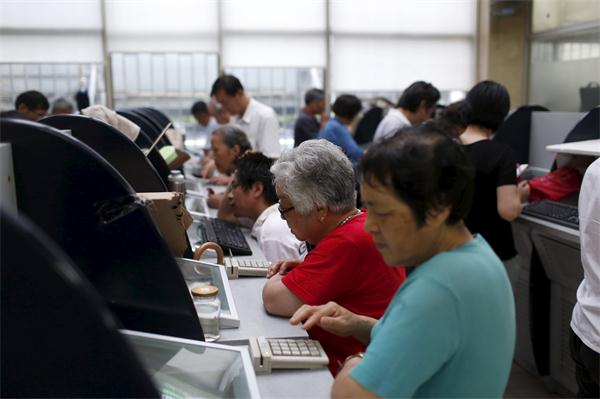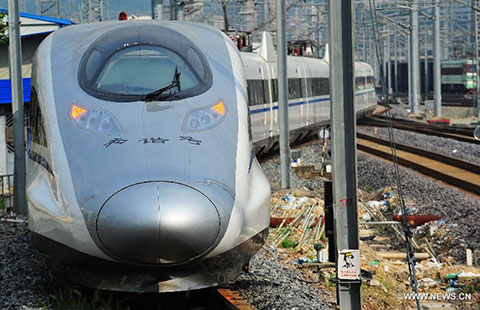Pension plan show confidence in health of stock market
By Zhu Qiwen (chinadaily.com.cn) Updated: 2015-06-30 15:21
 |
|
Investors look at computer screens showing stock information at a brokerage house in Shanghai, China, June 29, 2015. [Photo/Agencies] |
The coincidence of a dreadful drop in Chinese shares and the release of a draft guideline on Monday signaling China's pension fund will be allowed to invest in the stock market does not necessarily mean that policymakers are desperate to boost the market as many retail investors might believe.
However, since the urgency to stabilize the domestic stock market allows no ambiguity in government signals, Chinese policymakers should pay attention to the timing of such signals.
In spite of the central bank’s efforts on Saturday to cut both the requirement reserve ratio and key interest rates, the ailing Chinese stock market showed no signs of recovery, with the benchmark Shanghai composite index experiencing a rollercoaster 10.07 percent volatility on Monday.
The fact that global stock markets had taken a battering on Monday, after Greece shuttered its banks for the week and imposed limits on cash withdrawals, may partly explain why China’s monetary easing did not work the magic of immediately lifting the market’s spirits. Yet, even in the absence of such an external shock, it should not be too surprising that the Chinese stock market keeps falling nowadays after a strong bullish cycle since late 2014 sent the index from about 2,000 points to more than 5,000 points in early June.
However, the ongoing correction is more drastic than most people expected. Hence, Chinese policymakers need to take urgent measures to avoid market panic that will not only hurt the stock market but also affect the country’s overall economic growth.
But the introduction of the pension fund into the domestic stock market should not be one of those emergent aids.
There is no doubt about the merit of the draft guideline, as the government needs to address the looming challenge of a rapidly aging population that has made the adequacy and safety of the pension fund a growing concern for Chinese wage-earners.
The experiences of other countries show diversified investment is essential to maintain and increase the value of a country’s pension fund, and the draft guideline, which would give the pension fund the green light to invest in stocks and equities up to 30 percent of its total net assets, is an attempt to do this; although the percentage may be open to debate.
The participation of such a huge institutional investor represents both a vote of confidence in the long-term development of the domestic stock market and a step forward to improve the depth and width of the market to make it more stable. The participation of too many retail investors, who often trade their shares more frequently than institutional investors, has made the Chinese stock market more volatile than stock markets in developed markets.
But if the Chinese stock market develops into a healthy market that properly mirrors the underlying strength of the Chinese economy, there is no reason to keep the pension fund outside of this investment channel. After all, the safety of the pension fund should also mean an investment return that can effectively beat inflation in the long run.
China's senior citizens over 65 years old already make up about 10 percent of the country's population and the ratio may rise to one-third by 2050. The need to improve the returns on investment by is more than obvious, and putting part of the social security fund into the stock market is an established way to do this in other countries.
However, the Chinese government has been justifiably cautious due to the immaturity of the domestic stock market. The recent bull run and improved supervision of the domestic market seems to have encouraged the authority to finally make such a breakthrough move. Thus, selling the move as an expedient means to boost the Chinese stock market simply makes no sense: distant water cannot put out a fire at hand.
The author is a senior writer with China Daily
zhuqiwen@chinadaily.com.cn
- Anbang buys respected Belgian bank
- Carlyle Group takes a stake in JIC Leasing
- CNNC plans to bid for Slovakian nuclear power plant
- Stocks post biggest gain since 2009 as volatility soars
- Carlyle Group invests $120 million in Shanghai ANE Logistics
- Myanmar's joining in AIIB to benefit infrastructural construction
- China welcomes more EU participation in Chinese urbanization
- Drastic correction not good for market, says commission

















